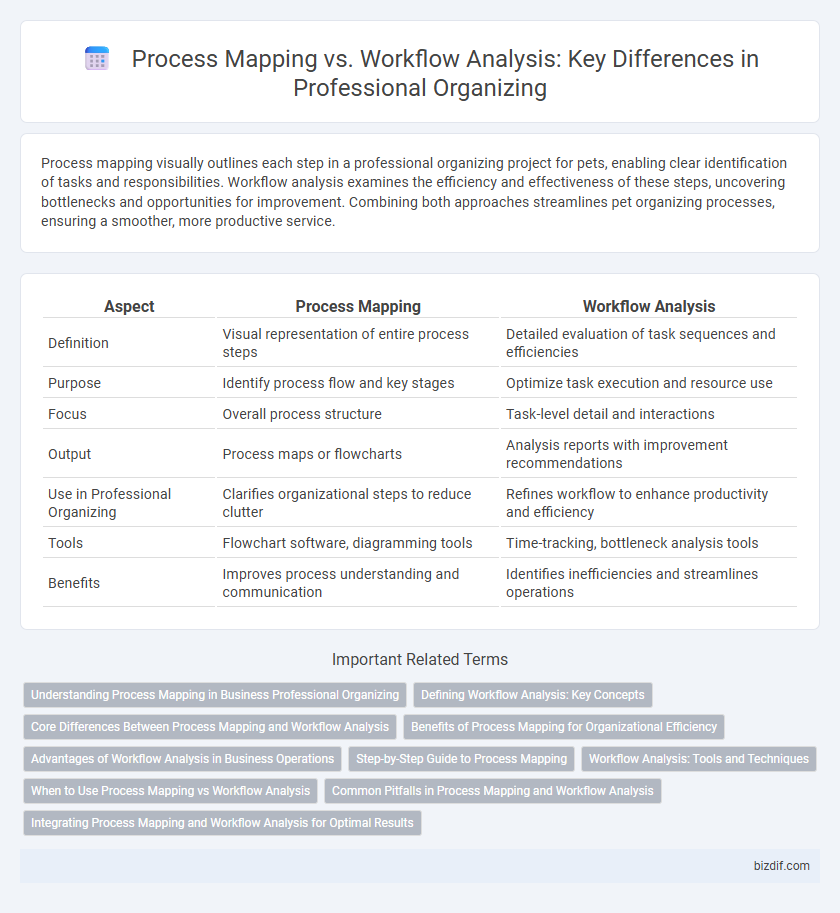Process mapping visually outlines each step in a professional organizing project for pets, enabling clear identification of tasks and responsibilities. Workflow analysis examines the efficiency and effectiveness of these steps, uncovering bottlenecks and opportunities for improvement. Combining both approaches streamlines pet organizing processes, ensuring a smoother, more productive service.
Table of Comparison
| Aspect | Process Mapping | Workflow Analysis |
|---|---|---|
| Definition | Visual representation of entire process steps | Detailed evaluation of task sequences and efficiencies |
| Purpose | Identify process flow and key stages | Optimize task execution and resource use |
| Focus | Overall process structure | Task-level detail and interactions |
| Output | Process maps or flowcharts | Analysis reports with improvement recommendations |
| Use in Professional Organizing | Clarifies organizational steps to reduce clutter | Refines workflow to enhance productivity and efficiency |
| Tools | Flowchart software, diagramming tools | Time-tracking, bottleneck analysis tools |
| Benefits | Improves process understanding and communication | Identifies inefficiencies and streamlines operations |
Understanding Process Mapping in Business Professional Organizing
Process mapping in business professional organizing involves visually outlining each step of a specific process to identify inefficiencies and optimize task flow. This technique provides a clear, detailed representation of how activities interconnect, enabling organizers to streamline operations and improve productivity. Understanding process mapping lays the foundation for effective workflow analysis by highlighting areas for potential improvement and resource allocation.
Defining Workflow Analysis: Key Concepts
Workflow analysis involves examining and defining the sequence of tasks, roles, and processes required to complete a project efficiently. It focuses on identifying bottlenecks, redundancies, and opportunities for optimization in task execution. Defining clear processes and responsibilities enhances productivity and ensures alignment with organizational goals.
Core Differences Between Process Mapping and Workflow Analysis
Process mapping visually outlines each step within a process to provide a clear, high-level overview of activities and sequence, while workflow analysis delves deeper into task-level details, focusing on efficiency, bottlenecks, and resource allocation. Process mapping emphasizes structure and flow between stages, whereas workflow analysis targets operational improvements and performance metrics within those steps. Understanding these core differences enables professional organizers to choose the right methodology for optimizing organizational systems and enhancing productivity.
Benefits of Process Mapping for Organizational Efficiency
Process mapping visually outlines each step within a business process, revealing inefficiencies and redundancies that hinder organizational productivity. By providing a clear, detailed overview, process mapping enables teams to identify bottlenecks, streamline operations, and improve communication across departments. This clarity fosters better decision-making and enhances overall organizational efficiency through optimized resource allocation.
Advantages of Workflow Analysis in Business Operations
Workflow analysis enhances business operations by identifying bottlenecks and inefficiencies, enabling targeted improvements that streamline processes. It provides a comprehensive view of task sequences and resource allocation, fostering better communication and collaboration across teams. This results in increased productivity, reduced operational costs, and improved project delivery timelines.
Step-by-Step Guide to Process Mapping
Step-by-step process mapping breaks down complex workflows into detailed visual diagrams, highlighting each task's sequence and responsible party. This technique enhances clarity by identifying bottlenecks and inefficiencies, enabling precise improvements in professional organizing projects. Compared to workflow analysis, process mapping offers a more granular view of task interactions, facilitating targeted optimization and streamlined operations.
Workflow Analysis: Tools and Techniques
Workflow analysis employs tools like flowcharts, Gantt charts, and Kanban boards to visualize and optimize task sequences and resource allocation. Techniques such as time-motion studies, root cause analysis, and value stream mapping identify bottlenecks and inefficiencies within professional organizing processes. Leveraging software solutions like Trello, Asana, or Microsoft Project enhances real-time tracking and collaborative refinement of workflows for improved productivity.
When to Use Process Mapping vs Workflow Analysis
Process mapping is best used when visualizing complex processes to identify inefficiencies and redundancies, providing a high-level overview for strategic planning. Workflow analysis is ideal for examining detailed task sequences and communication flow within specific operations to enhance productivity and task management. Use process mapping during initial assessments to outline the overall process structure, and apply workflow analysis during optimization phases to refine individual steps and improve operational execution.
Common Pitfalls in Process Mapping and Workflow Analysis
Common pitfalls in process mapping include overcomplicating diagrams with excessive detail and failing to involve key stakeholders, which can lead to inaccurate representations. In workflow analysis, ignoring informal processes and not accounting for variations in task sequences often results in incomplete insights. Both approaches suffer when there is a lack of clear objectives, causing misalignment between documented processes and actual organizational practices.
Integrating Process Mapping and Workflow Analysis for Optimal Results
Integrating process mapping and workflow analysis enhances professional organizing by providing a comprehensive view of operations and identifying inefficiencies. Process mapping visually outlines each step, while workflow analysis examines task sequences and resource allocation for smoother execution. Combining these methodologies enables organizations to optimize productivity, reduce redundancies, and streamline workflows effectively.
process mapping vs workflow analysis Infographic

 bizdif.com
bizdif.com